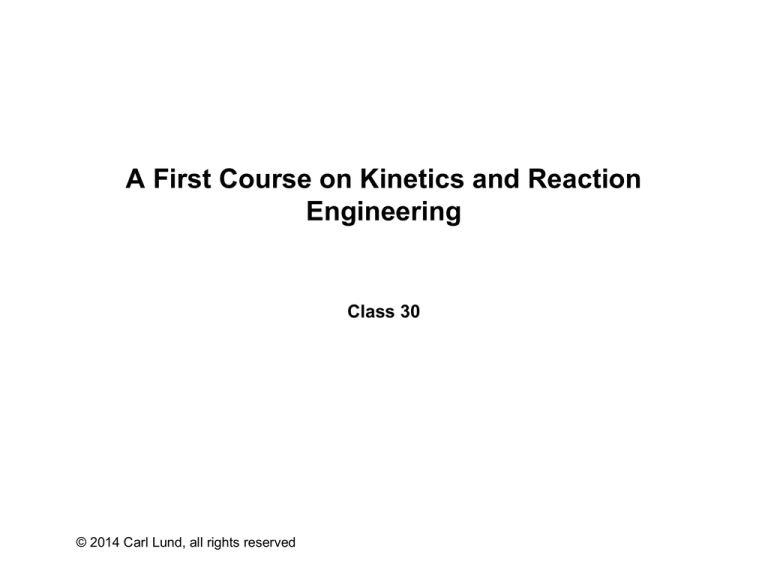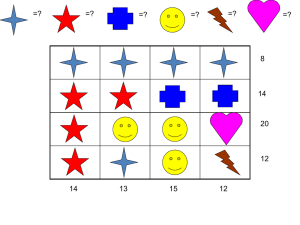
A First Course on Kinetics and Reaction
Engineering
Class 30
© 2014 Carl Lund, all rights reserved
Where We’re Going
• Part I - Chemical Reactions
• Part II - Chemical Reaction Kinetics
• Part III - Chemical Reaction Engineering
‣ A. Ideal Reactors
‣ B. Perfectly Mixed Batch Reactors
‣ C. Continuous Flow Stirred Tank Reactors
‣ D. Plug Flow Reactors
-
25. Reaction Engineering of PFRs
26. Analysis of Steady State PFRs
27. Analysis of Transient PFRs
‣ E. Matching Reactors to Reactions
-
28. Choosing a Reactor Type
29. Multiple Reactor Networks
30. Thermal Back-Mixing in a PFR
31. Back-Mixing in a PFR via Recycle
32. Ideal Semi-Batch Reactors
• Part IV - Non-Ideal Reactions and Reactors
Thermal Back-Mixing of a PFR
• The PFR design equations are the same as a stand-alone PFR
‣ Often you can’t solve them independently because the inlet temperature, Tb, is not specified
• Design equations for the heat exchanger
‣ Energy balance
‣ Heat transfer equation (one of the following)
-
-
•
DTLM =
•
DTAM =
DTcold
(Td - Ta ) - (Tc - Tb )
ì (Td - Ta ) ü
ln í
ý
T
T
î( c d ) þ
Tc + Td Ta + Tb
2
2
= Td - Ta
Analysis of an Integrated Heat Exchanger and PFR
• Make a simple schematic and label each of the streams
• Assign each quantity that is specified in the problem statement to the
appropriate variable
• Set up the design equations for the PFR
‣ If there is sufficient information to solve the PFR design equations
- Solve the PFR design equations
- Use the results to solve the heat exchanger design equations
‣ If the PFR design equations cannot be solved independently
- Set up the two design equations for the heat exchanger
- In preparation for solving the heat exchanger design equations numerically, choose Tb as
one of the unknowns and do not choose Tc or any molar flow rate as the other unknown
- Solve the heat exchanger design equations numerically
The code you must provide will be given Tb
‣ knowing that, you can solve the PFR design equations to obtain Tc and any
unknown molar flow rates
‣ knowing those, you can evaluate the heat exchanger design equations
- Once the heat exchanger design equations are solved, use the results to solve the PFR
design equations
•
• Answer the questions posed in the problem statement
Questions?
An acid, A, is to be hydrolyzed according to the reaction A + W → P, where
W represents water and P, the product. The acid will be fed to an adiabatic,
steady state PFR at 0.07 kmol/s and water will be fed at 1.67 kmol/s. This
gives a total feed flow of 0.04 m3/s. The feed temperature is 300 K. The fluid
volume of the PFR is 0.5 m3. The rate expression is given in equation (1),
with the rate coefficient given in equation (2) and the equilibrium constant in
equation (3). The heat of reaction is -86,000 kJ/kmole at 298 K. The heat
capacities of A, W, and P are 412, 76, and 512 kJ/(kmol K), respectively,
and may be taken to be independent of temperature. Compare the
conversions and final temperatures when (a) the feed enters the PFR
directly and (b) when the product stream is used to heat the feed (assume a
5 K cold approach).
é
CP ù
r1 = kC ACW ê1ú
ë KC ACW û
(1)
ì -13000K ü
k = 1.2 ´ 10 m kmol s exp í
ý
T
î
þ
(
(
12
K = 4.2 ´ 10
-15
3
-1
-1
)
ì11300K ü
m kmol exp í
ý
î T
þ
3
-1
)
(2)
(3)
Activity 30.1
• In this activity you will practice the general approach for analyzing an
integrated heat exchanger and PFR.
• It also illustrates a problem where the cold approach is specified and used
•
as one of the heat exchanger design equations instead of the heat
transfer equation
Perform all work for this activity on the worksheet that has been provided
Sketch of the System
• Make a sketch of the system, labeling each flow stream.
Identify Known Quantities
• Read through the problem statement. Each time you encounter a quantity,
write it down and equate it to the appropriate variable. When you have
completed doing so, if there are any additional constant quantities that you
know will be needed and that can be calculated from the values you
found, write the equations needed for doing so.
PFR Design Equations
• Generate the design equations needed to model the PFR by simplification
of the general PFR design equations found in Unit 17 or on the
AFCoKaRE Exam Handout.
Numerical Solution of the PFR Design Equations
• Identify the specific set of equations that needs to be solved and within
those equations identify the independent and dependent variables, if
appropriate, and the unknown quantities to be found by solving the
equations.
• Assuming that the PFR design equations will be solved numerically,
specify the information that must be provided and show how to calculate
any unknown values.
Heat Exchanger Design Equations
• Set up the heat exchanger design equations (energy balance and either
heat transfer equation or specified approach).
Numerical Solution of the Heat Exchanger Design
Equations
• Identify the specific set of equations that needs to be solved and within
those equations identify the independent and dependent variables, if
appropriate, and the unknown quantities to be found by solving the
equations.
• Assuming that the heat exchanger design equations will be solved
numerically, specify the information that must be provided and show how
to calculate any unknown values.
Solution
• Solve the design equations and use the results to answer the questions
asked.
Where We’re Going
• Part I - Chemical Reactions
• Part II - Chemical Reaction Kinetics
• Part III - Chemical Reaction Engineering
‣ A. Ideal Reactors
‣ B. Perfectly Mixed Batch Reactors
‣ C. Continuous Flow Stirred Tank Reactors
‣ D. Plug Flow Reactors
-
25. Reaction Engineering of PFRs
26. Analysis of Steady State PFRs
27. Analysis of Transient PFRs
‣ E. Matching Reactors to Reactions
-
28. Choosing a Reactor Type
29. Multiple Reactor Networks
30. Thermal Back-Mixing in a PFR
31. Back-Mixing in a PFR via Recycle
32. Ideal Semi-Batch Reactors
• Part IV - Non-Ideal Reactions and Reactors





